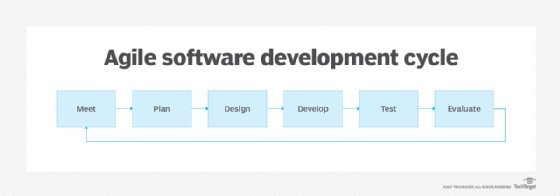Agile operations (AgileOps)
What is AgileOps?
Agile operations, or AgileOps, is a digital business operating model that builds on Agile methodologies and DevOps techniques to help organizations adapt to change quickly and efficiently. AgileOps is an umbrella term centered around helping operations and developers work closely with business leaders, data analysts and the overall organization.
Why is AgileOps important?
In addition to software development teams using it to help maintain their systems, other teams can also employ AgileOps. The aim of AgileOps is to enable infrastructure and operations teams to focus on the deployment, operations and ongoing support of digital services and applications created in Continuous development and continuous delivery environments. Although operations teams have been monitoring IT infrastructure and applications since digital technology's early days, today's complex collection of operations requires nimble navigation to monitor performance. This includes environments where mainframes and other legacy systems coexist with cloud, as-a-service, and containerized or virtualized offerings, as well as artificial intelligence and the internet of things.
AgileOps helps organizations keep up with changing business needs by planning technology quickly. "In this environment, nontechnical individuals will work more and more with technical individuals, and IT workers will be more strategically placed within an organization," said James Stanger, chief technology evangelist at CompTIA.

How does AgileOps work?
The concept of AgileOps is based on continuous integration, evaluation and delivery of services. It is the antithesis of the traditional waterfall model, which provided a sequential strategy for software development. As with Agile methodology and DevOps, AgileOps is aimed at fostering teamwork and bringing about a cultural change from earlier, more siloed strategies.
Agile software development is a type of development and project management methodology in which solutions evolve through cooperation and partnership among self-organizing cross-functional teams. Agile development often requires a cultural shift in many companies because it emphasizes the seamless delivery of individual pieces of the software rather than the entire application. Often incorporating Agile methodology, DevOps is a set of best practices to enable significantly faster, more efficient and more agile delivery of high-quality software. With DevOps, developers and operations teams work together, rather than in isolation.
AgileOps takes the tenets of Agile methodology and DevOps further to the rest of the organization. It is meant to continuously align all IT operations into the needs of the organization.
With AgileOps, workflow management entails a kanban style of communication. Teams often use a board to display specific steps of a project, elements of the supply chain and needs. To keep consistent track of all elements, the board might include three columns that read "Requested," "In Process" and "Complete," for example. The purpose of the board is to show real-time information about teams and individuals who are working on a software project or an assembly line. It helps identify bottlenecks and additional issues.
Continuous, incremental improvement is essential for AgileOps to be successful. It's important to emphasize process improvement and adjustment to rapid shifts in a specific business sector. While companies often complete tasks by handing them off from one group to another, AgileOps' focus on cross-functional teams helps eliminate delays and other challenges.
At the core of AgileOps is a focus on the effectiveness of communication. "[Teams] have to have a very strong communication path and a strong feedback mechanism," Stanger said. Organizations also require good written documentation, mature operational processes, secure and stable systems, and robust project management. "Organizations need data showing where various teams are along the development of the project," he added.
What are other attributes and key benefits of AgileOps?
AgileOps can help organizations identify and remedy performance problems and apply this information for testing, development and quality improvement. It can also monitor both applications and infrastructure performance. By enabling a more proactive approach to IT monitoring, AgileOps can help companies reduce Technical debt and adjust quickly to evolving business goals.
In addition to offering a flexible IT environment that enables IT workers to respond rapidly to changing business needs, other benefits of Agile operations include the following:
- AgileOps frequently offers the incentive for individuals to form ad hoc teams to resolve a specific issue or take an opportunity, instead of relying on management to drive innovation.
- The key performance indicators of AgileOps center around the number of successful business services offered, rather than traditional lines of code or software issues resolved.
- With AgileOps, the IT team or teams can focus on product and process improvement, and not just bug fixes.
- The focus tends to be on the criticality of a specific need or business solution, rather than the strength of a management personality.







